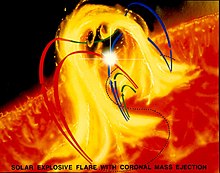Coronal mass ejection

A coronal mass ejection ( English coronal mass ejection , CME ) is a solar flare (a eruptive protuberance ) at which the plasma is ejected. If the effects are investigated at a great distance from the sun, one also speaks of interplanetary coronal mass ejection ( ICME ).
The sources of exit are mostly sunspots , the eruptions of which are also known as flares (English flare , bright, flickering light). The ejected plasma consists mainly of electrons , protons and, to a small extent, nuclei of heavier elements such as helium , oxygen and iron . Presumably, reconnections of the magnetic field lines cause the eruptions.
The frequency of coronal mass ejections is closely linked to solar activity : in the sunspot minimum they are significantly less common than in the sunspot maximum, the average frequency fluctuates between 0.5 events and 6 events per day. The distribution of the intensities obeys a scale law .
Influence on the earth
The few CMEs that actually target Earth (the Earth appears to be only 17.6 "in size when viewed from the Sun , roughly like the head of a pin from 10 meters away) are known as geo-effective and affect the magnetosphere and ionosphere Earth: the magnetosphere is compressed on the day side, the tail is elongated on the night side. Large amounts of energy are released, which among other things leads to pronounced polar lights . CMEs can cause damage to satellites and due to the increased electron density in the Ionosphere radio transmissions disrupt, more on this under Magnetic Storm .
In August 2011, STEREO-A was able to observe the direct impact of a plasma cloud on earth for the first time. Further knowledge was gained in 2012 with the research satellite TIMED .
At the end of August 1859, the strongest coronal event in history was observed in North America with bright daylight phenomena at night and destructive magnetic inductions in telegraph lines. The various effects are described in space weather . These events are called the Carrington events after the discoverer . In December 1956 and November 2003 the strongest recorded eruptions so far occurred.
Based on a C14 anomaly in the sediments of the Cariaco Basin, the independent researcher Paul A. LaViolette proposes the hypothesis that a huge coronal mass ejection in 12,837 BP with radiation doses of up to 3–6 Sievert in 3 days and a destruction of the The ozone layer was the cause of the quaternary extinction wave . Other researchers contradict the thesis, since the extinction has been shown to extend worldwide over thousands of years and cannot be correlated with a singular event.
Triggering of magnetohydrodynamic waves (MHD wave)
In the case of a coronal mass ejection, waves also propagate in the plasma of the solar surface from the location of the ejection . These magnetohydrodynamic waves reach enormous heights of several thousand kilometers and their fronts extend for hundreds of thousands of kilometers. It is hoped that observing these waves will provide further clues about the physics of the sun and make better predictions about space weather . In 1997, the solar observation satellite SOHO gave the first indications of such waves . These observations were confirmed in February 2009 by the STEREO satellites.
Trivia
The term “solar storm” is often used in the media and in the pseudoscientific scene. Its origin is unknown. Most often it is associated with the occurrence of a coronal mass ejection or a magnetic storm. Magnetohydrodynamic waves are also often referred to as “solar tsunamis ” in the media .
See also
literature
- H. Kunow: Coronal mass ejections. Springer, Berlin 2006, ISBN 978-0-387-45086-5
- Kenneth Dere: Coronal and stellar mass ejections. Cambridge Univ. Press, Cambridge 2005, ISBN 0-521-85197-1
Web links
- The Solar Mass Ejection Imager
- NASA Images
- FLARES & CMEs SOHO -Gallery
- S1 solar storm on June 7, 2011 (video)
- CME Arrival Time Prediction @ iNTEGRATED SPACE WEATHER ANALYSIS SYSTEM, gsfc.nasa.gov, accessed June 5, 2020
- WSA-Enlil Solar Wind Prediction - CME based noaa.gov, accessed January 22, 2012
Individual evidence
- ↑ Nat Gopalswamy, Alejandro Lama, Seiji Yashiro, Steven Nunes, and Russell A. Howard: Coronal Mass Ejection Activity during Solar Cycle 23. ( Online )
- ↑ Tabula rasa im All spiegel.de, accessed on January 22, 2012
- ↑ Spacecraft Solar Storm Lake Engulf Earth science.nasa.gov, accessed 20 August 2011
- ^ Solar Storm Dumps Gigawatts into Earth's Upper Atmosphere science.nasa.gov, accessed March 23, 2012
- ^ Paul A. LaViolette: Evidence for a Solar Flare Cause of the Pleistocene Mass Extinction . In: Dept. of Geosciences, University of Arizona (Ed.): Radiocarbon . No. 53 (2) , June 2011, pp. 303-323 , doi : 10.2458 / azu_js_rc.53.3464 .
- ^ Anthony J. Stuart: Late Quaternary megafaunal extinctions on the continents: A short review . In: Liverpool Geological Society (Ed.): Geological Journal . No. 50 (3) , December 2014, p. 342 , doi : 10.1002 / gj.2633 .
- ↑ https://www.nasa.gov/mission_pages/stereo/news/solar_tsunami.html
- ↑ http://iopscience.iop.org/article/10.1088/0004-637X/700/2/L182/meta
- ↑ https://stereo.gsfc.nasa.gov/news/SolarTsunami.shtml



